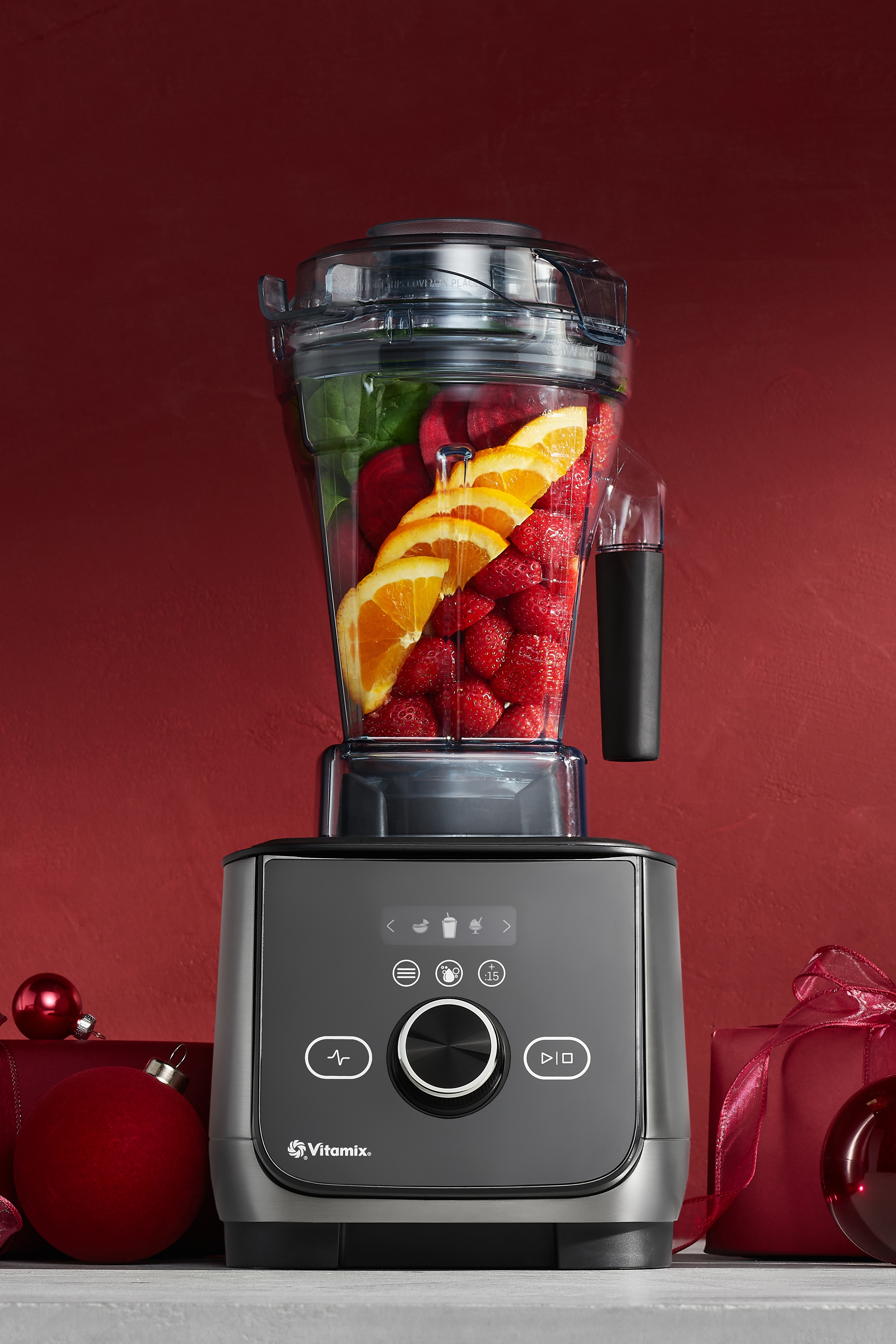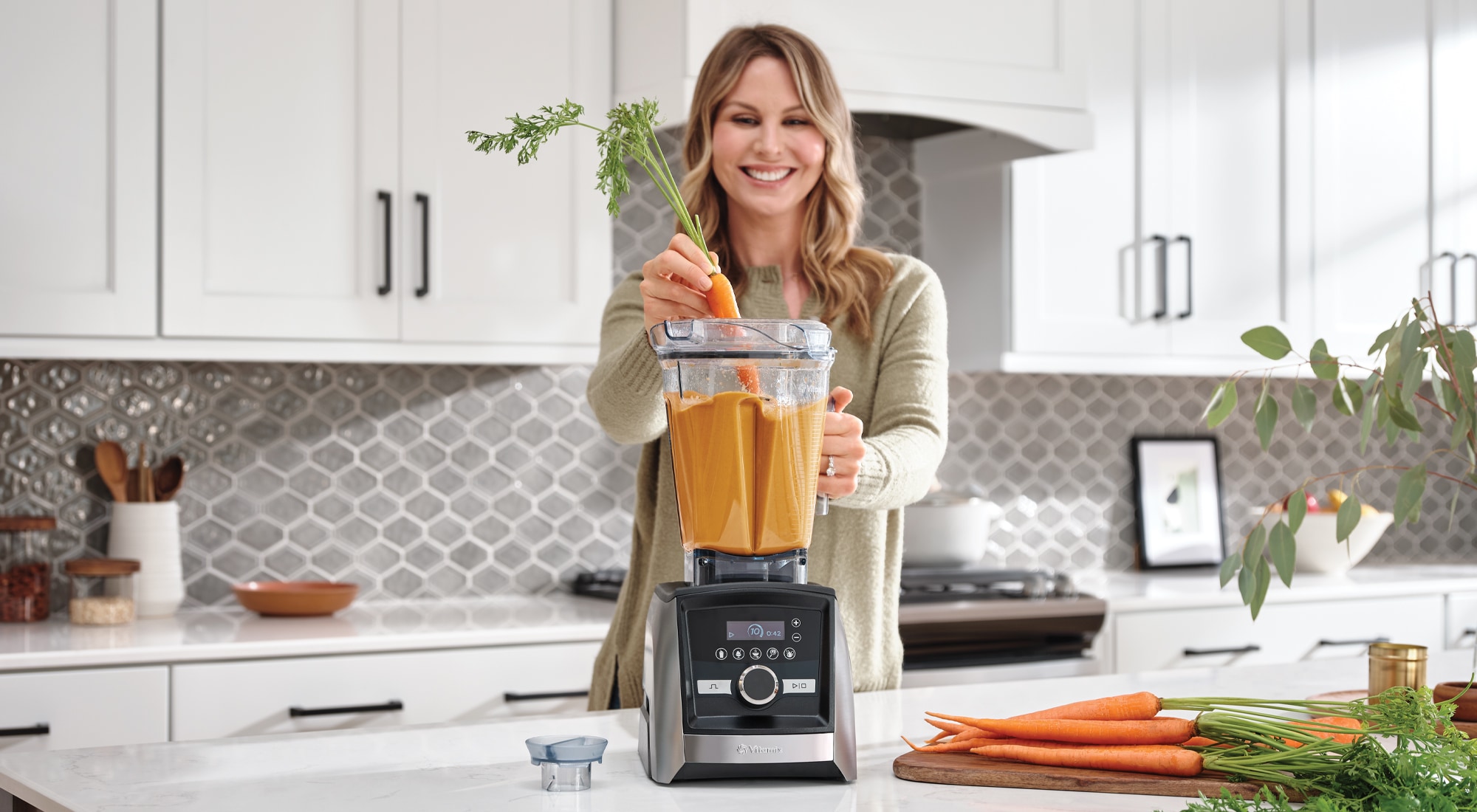How Do Blenders Work?
It doesn’t matter if you’re a novice cook or a seasoned chef, a blender plays an indispensable role in any kitchen. The blender was originally invented to mix milkshakes, so its evolution into the perfect smoothie maker was a natural one. But today, modern blenders are high-performance kitchen appliances that can make steaming hot soups, frosty cold desserts, and almost everything in between.
So why do most blenders get stuck on smoothie duty? Because most people don’t know how many things a high-powered blender can do. Let’s take a comprehensive look beyond basic blending. We’ll explore how to use a blender and become familiar with the different types of blenders, their components, and their functions, so you can choose the best blender for your needs. Next, we’ll discuss blender safety and maintenance, because a well-kept blender can last a long time. Then we’ll get to the fun stuff, like basic blender tips and tricks for the perfect blend and advanced blender techniques for making amazing whole-food meals.
Ready to take a deep dive into how blenders work? Let’s go!
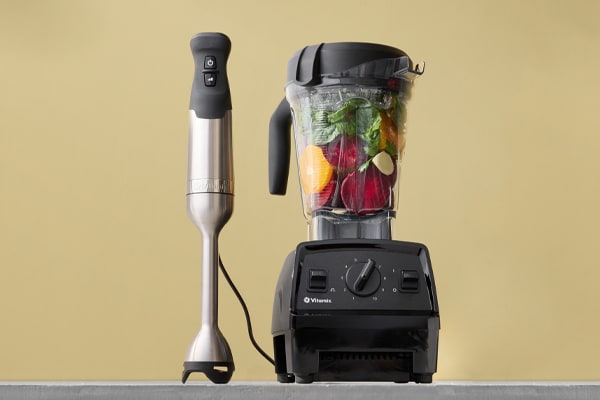
Understanding Your Blender
Get Ready to Meet Your Match
Before we get into the components of a blender and how they function, let’s look at the three main blender types: countertop, immersion, and personal.
Countertop Blenders
Countertop blenders do just what their name suggests; they sit on your kitchen countertop, ready to help you perform a wide variety of culinary tasks. The classic countertop blender is typically comprised of a motor base underneath a blending container with blades inside.
The blending container is removable and usually holds 48-64 ounces. It can be made of glass, plastic, or stainless steel. A removable lid keeps the contents in the blending container, preventing spills and splatters. The lid often has a port through which ingredients can be added, and a cap that covers the port.
The motor base has a control panel that lets you turn the machine on and off, blender speed settings, and select pre-set blending programs. For ease of use, most countertop blenders have control panels with buttons for the most common blender functions. Many blenders also have a self-cleaning option which lets you blend the container clean.
Countertop blenders can really do a lot in the kitchen. They’re great for making smoothies, frozen desserts, hot soups, sauces, and more. With its large blending container and powerful motor, the countertop blender is perfect for cooking for a crowd. Each is incredibly versatile, and powerful enough to pulverize a full container of ingredients.
Immersion blenders
Also called a stick or hand blender, the immersion blender is a hand-held kitchen tool that lets you blend directly in the pot, jar, or bowl you’re using. Instead of being confined to the counter, you’re free to roam the kitchen and blend where you need to.
The typical immersion blender that home cooks use is a 12 to 14-inch long, cylindrical stick with a motor on top and blades at the bottom. The immersion blender’s handle is the motor unit which houses the motor that powers the blades. The power button and control setting are usually located here as well. Because immersion blenders are designed to complement countertop blenders rather than compete with them, they usually have less powerful motors. A 200 or 250 watt motor typically gets the job done.
The blending shaft is the part of an immersion blender that’s placed directly into the ingredients. It contains the blades, which are covered by a bell-shaped blade guard that prevents splatters and protects the container you’re blending in. Some immersion blenders come with accessories like a whisk that can be attached to the blending shaft in place of the blades. Most blending shafts are dishwasher-safe and easy to clean. You can also fill a wide-mouth jar with warm soapy water, submerge the blades, and blend for 10 to 20 seconds.
To plug in or not to plug in, that is the question. Even though portability is the immersion blenders biggest selling point, most immersion blenders come with a cord that requires some proximity to an electrical outlet. Some newer blenders do run on rechargeable batteries and, as technology improves, cordless immersion blenders might become more popular.
Like their countertop counterparts, immersion blenders can make smoothies, sauces, and dips. They’re also great for blending small batches and emulsifying ingredients for things like salad dressings and mayonnaise. The Vitamix Immersion Blender lets you create ideal textures from whole-food ingredients and enjoy the convenience of blending in your favorite container.
Personal Blenders
Looking a lot like a mini-countertop blender, a personal blender is essentially a small blending container with blades inside sitting on top of a lightweight motor base. The average personal blender’s motor is small but powerful enough to blend fruit and crush ice, which is perfect for making smoothies, protein shakes, and frozen drinks. Personal blenders usually have just a single speed, but there are some with 2 speeds or a pulse feature.
The blending container is the personal blender’s secret weapon – it doubles as a travel cup! Because it’s designed to accompany you on the go, most personal blender jars are made of a really durable, shatter-resistant plastic. They typically have two lids: one for blending and a leak-proof one with a drinking spout. Most personal blenders can hold anywhere from 12 to 32 ounces, the same size range as most store-bought beverages.
If you’ve spent any time on social media, you know that personal blenders are hotter than ever. Some personal blenders come in bright colors and busy prints. They’re perfect for the beach, gym, or dorm rooms and they’re specifically designed to make micro-batches of the drinks you’d enjoy in those places. Because they were created to capitalize on the current smoothie craze, some lower-end personal blenders are not built for the long haul.
If you’re looking for a personal blender that will outlast the next ten food trends, try the Personal Cup Adapter or Blending Cup (if you have an Ascent or Venturist Series) from Vitamix. These attachments transform your full-size Vitamix machine into a personal blender. You can make smoothies right in the blending cup and take it on the go.
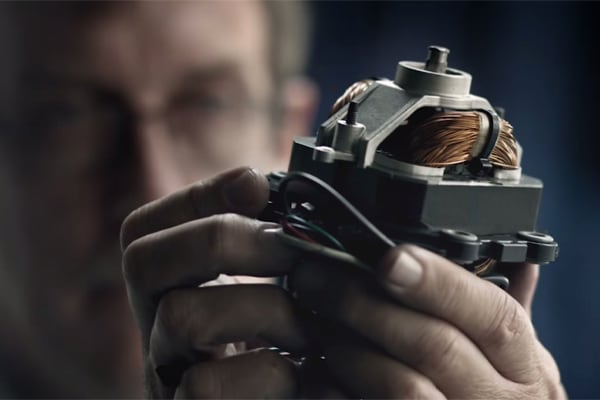
Under the Hood
Now that we’re familiar with the different categories of blenders, let’s take a look at the three main components all blenders share and how they work together.
Motor
The motor is the engine of the blender. A good motor should move the blades with enough force to break down ingredients. Most manufacturers measure the power of a blender’s motor in horsepower (some measure in watts; just remember 1 horsepower equals 746 watts). Because of its size and blending capacity, a countertop blender has the most powerful motor.
Does the best blender have the highest horsepower? Not exactly. Some manufacturers list peak horsepower, while others use running horsepower. What’s the difference? Peak horsepower refers to the burst of power the motor needs to overcome resistance, like when you’re blending tough ingredients. Running horsepower, on the other hand, refers to the amount of power used during normal operating conditions. Most countertop blenders get the job done with 1-2 horsepower.
Vitamix motors are known for their power, but it’s their engineering that produces exceptional blends. Vitamix motors are designed to maintain an even torque and cool temperature to consistently deliver the power to process any ingredient, while a metal drive system offers maximum durability.
Blades
Because a blender can liquefy solid ingredients with a touch of a button, most people assume the blades are very sharp, but they’re often not. The blades of most blenders pulverize ingredients rather than slice them. The motor moves the blades with enough force to break apart any ingredient they touch.
Most blenders have a configuration of four blades arranged at different angles to maximize contact between the blades and the ingredients thus enhancing the blending process. A high performance countertop blender has a motor that can move blades fast enough to create friction and heat the ingredients in the container.
Vitamix blades are precision laser-cut from aircraft-grade stainless steel and attached to the base with a double bearing assembly. That’s engineering speak for: Our blades are built to last a really long time.
Container
If you think the blending container is the least complex of the three main components, think again. Your blending container’s design plays a big part in the quality and consistency of your blends. The tall, tapered shape creates a vortex that pulls ingredients toward the blades for optimal blends. (This refers to countertop and personal blenders; immersion blenders are designed to blend in a variety of containers.)
The three parts work together in harmony: The motor spins the blades which create a vortex in the container that processes the ingredients. A blending container’s size, shape, and blade configuration can be engineered to perform specific culinary techniques. Vitamix makes a blending container for every task – here are some to explore.
Vitamix 64-Ounce Container
Ideal for large batches, the 64 oz. container blends 6-12 servings in a single blend. This comes in a taller classic size or low-profile, which is designed for an easy fit under most kitchen cabinets.
Vitamix 48-Ounce Container
This container helps you avoid food waste by letting you make the right amount for your needs. It’s perfect for small and medium batches.
Vitamix Aer Disc Container
This container has a flat disc at its base instead of the traditional blades. The patent-pending Aer Disc Container pulls liquid ingredients through its small holes as it spins, aerating and emulsifying them. Firmer ingredients like ice, fruit, and herbs are agitated but not puréed. In addition to emulsifying, this container lets you whip, muddle, and foam.
Dry Grains Container
The Dry Grains Container’s blades are specifically designed to create a reverse vortex, pushing dry ingredients away from the blades to prevent packing, so you can grind whole grains, mix batter, and simulate the kneading process with ease.
Color Containers
Color Containers are great for allergen-sensitive cooking and non-food blending. Just pick one of three colors, designate its use, and feel confident avoiding cross-contamination in the kitchen.
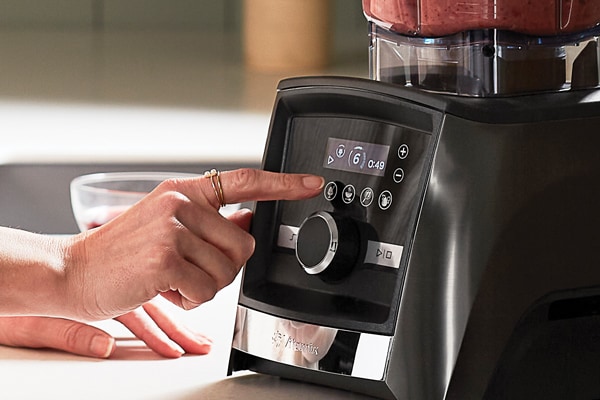
You’re in Control
Different recipes require different speeds. Adjusting your blender’s speed achieves the precise texture a recipe requires. User-friendly controls simplify even the trickiest of recipes, whether you're manually adjusting the blade speed or leaving it to an automated program. On most countertop blenders, speed is controlled with a turn of a dial, a touch of a button, or a combination of the two.
Dial Controls
A dial is an analog control that sits in the center of your blender’s control panel and lets you adjust your blender’s speed by physically turning a dial.
On Vitamix machines with Variable Speed Control, a smoothly rotating dial lets you manually control your machine’s speeds from level 1 to 10. The higher the speed, the smoother the blend. Use low speeds for things like chunky salsas and high speeds for fine purées. The Pulse feature operates at speed 5 to control the texture of your dish even further. Flip the Pulse switch on and off to quickly chop ingredients, refresh drinks, or get a blend going before cranking up the speed.
Button Controls
Buttons are digital controls that let you select pre-programmed speeds for the specific blending task you need. Make smoothies, steaming hot soups, and more with just a push of a button.
Vitamix blenders with Vitamix Program Speed come with convenient preset programs designed to blend many common recipes — simply push a button and your Vitamix blender does the work for you. Some Vitamix blenders have built-in timers that monitor the length of your blends to avoid over-processing.
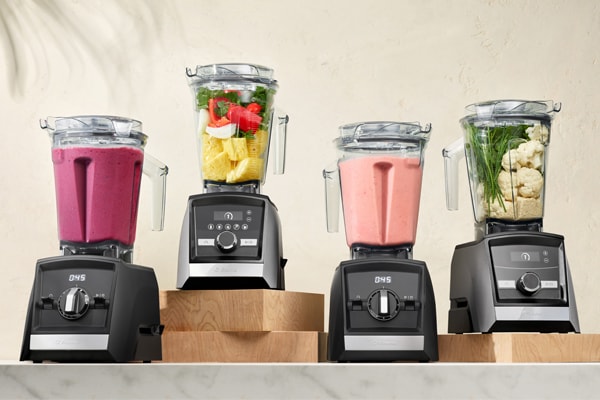
Choosing the Right Blender
Now that you have a better understanding of how blenders work, you should have a better idea of which blender type — countertop, immersion, or personal — is right for you.
| Countertop Blender | Immersion Blender | Personal Blender |
|---|---|---|---|
Capacity | 48 - 64 oz. | n/a | 18 - 32 oz. |
Power | 895 - 1650 W | 200 - 625 W | 200 - 1000 W |
Special Features | Preset programs, accessories | Accessories, bell guard | Travel lid |
If you’ve decided on a Vitamix® blender, but aren’t sure which model to choose, try the Blender Recommender. It will guide you through the different categories, features, and options – just answer a few simple questions, and we’ll suggest a blender model that matches your preferences.
And here’s a quick introduction to some of our best-selling Vitamix blender series:
Ascent Series blenders combine Vitamix power with wireless SELF-DETECT® technology, so you can mix and match containers and attachments to create your own personalized blending system.
Propel Series blenders combine iconic Vitamix performance backed by expert engineering with the convenience of preset blending programs.
Our Legacy Series blenders feature intuitive controls, award-winning design, and iconic Vitamix performance and durability.
Our Immersion Blender puts the power and performance of Vitamix in the palm of your hand and offers an array of attachments and accessories that add even more functionality and convenience.
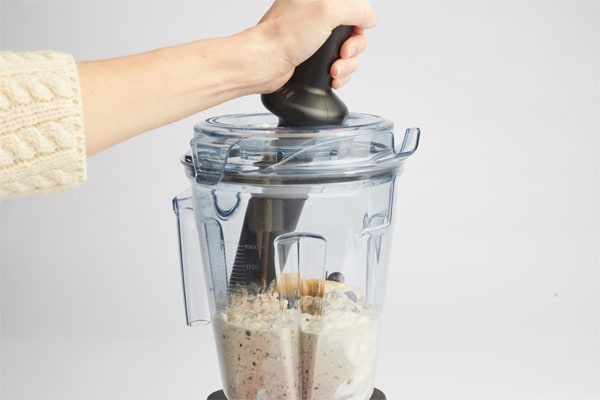
Blender Safety
As useful as blender are in the kitchen, they can be dangerous when used improperly. A blender’s powerful motor and spinning blade are designed help you move through culinary tasks with ease, but they can cause harm and injury if you’re not careful. Here are some tips for safe blending.
DO read the owner’s manual.
This sounds like a no-brainer, but how many times have you taken an appliance out of the box, plugged it in, and crossed your fingers? The owner’s manual has operating instructions and safety tips unique to your purchase that can help you get the most out of your machine.
DON’T place utensils, scrapers, or fingers in the blender while the motor is running. In general, it’s a good idea to unplug your blender when not in use, before putting on or taking off parts, and before cleaning.
DO use your tamper to process thicker mixtures and keep ingredients moving around and through the blades. This helps prevent cavitation, which occurs when air pockets forming around the blade.
DO be careful blending hot liquids in your blender. Let any hot liquids added to your recipe cool for 3-5 minutes before adding them to your blender. Use caution when working with hot liquids because spray or escaping steam may cause burns. If the blender lid isn’t vented, pressure may also build up causing the blending container to explode.
Vitamix blenders have a vented lid to release steam and reduce pressure when blending heated ingredients. The seal at the blade base of Vitamix blenders is also designed to prevent container explosions.
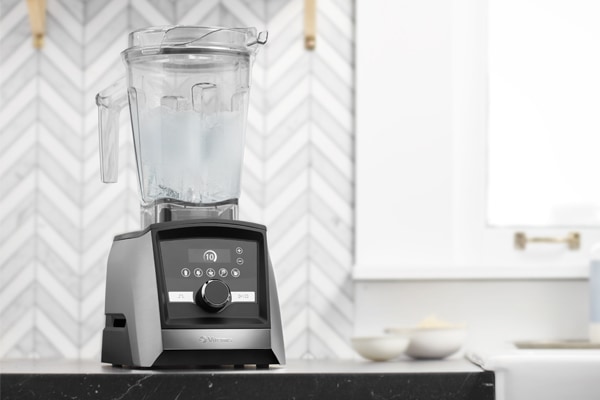
Blender Cleaning
The best thing you can do to keep your blender in tip-top shape is to keep it clean. Here are four tips to keep your machine working well for years to come.
Careful Cleaning
Never let foods dry in your blending container. This is especially important when making dense or sticky foods such as nut butters. The easiest way to keep your blender clean is to rinse your container immediately after each use to avoid clogging or damaging the container or blade.
Vitamix blenders are self-cleaning. Simply, fill the blending container halfway with warm water, add a drop of dish soap, and secure the lid. Start the machine and slowly increase to its highest speed. Run for 60 seconds and rinse with warm water.
Loading the Container
As a rule of thumb, add liquids first, followed by dry goods, leafy greens, fruits and vegetables, and, lastly, ice and frozen foods. Adding ingredients to the container in this order helps ensure the fastest, smoothest blends. LEARN MORE
Proper Ventilation
When your machine is in use, make sure the space around the blender base is uncluttered to allow the air to flow. To that end, every Vitamix blender is engineered with a cooling fan to prevent the motor from overheating.
For more tips (like how to clean a cloudy container!) CLICK HERE
Troubleshooting
Every once in a while, even the best-engineered machine can develop a hiccup. Your first course of action should be to consult the Owner’s Manual. Most manuals include a section on troubleshooting that will help you figure out what the problem is, how to fix it, and when to call one of customer service.
Generally speaking, we don’t recommend undertaking serious repairs yourself because you might inadvertently do something that voids the warranty. Here are some common issues and the advice we give Vitamix users.
“My Vitamix is shaking and vibrating.”
If your Vitamix machine is shaking and vibrating, check that it is set flat on a solid surface, such as your countertop, and not a cutting board or other non-fixed surface. Still shaking? There may be a problem with the feet on the bottom of your machine or the drive socket. If you suspect this is the case, please contact customer service.
“My Vitamix isn’t turning on.”
First, try resetting the outlet if your Vitamix is connected to a GFCI outlet. Didn’t do the trick? Check that the outlet is powered by plugging in another appliance. If the outlet has power and your machine still isn’t working, please contact customer service.
“My Vitamix is leaking around the lid or base.”
Your Vitamix is designed to keep liquids in your container. If you notice leaking around the rim of your lid or the tamper hole, please check that everything is tightly secured. A persistent leak should be addressed with a call to customer service. On the flip side, a leak around the base always requires a call to customer service. Although you may be tempted to tighten the screws or disassemble it to check on your own, the base assembly is precisely manufactured, and attempting to fix it on your own will void your warranty.
“My Vitamix is making a high-pitch screech!”
Please call customer service if your Vitamix is making a high-pitch screeching sound or other unusual noises.
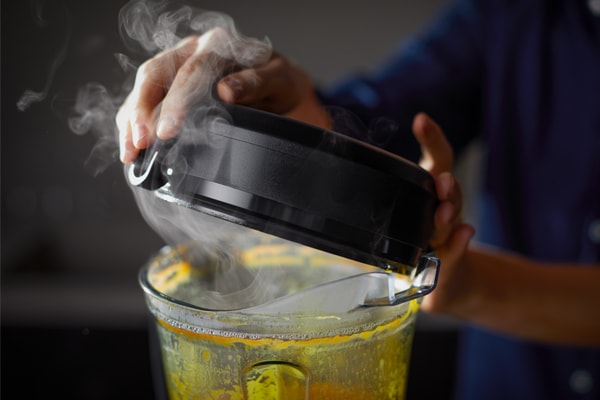
The Art of Blending
A machine as complex as a high-performance blender can do a variety of tasks in the kitchen. Let’s look at some basic functions most home chefs need.
Crushing Ice
The blades are key in crushing ice. There’s a misconception that blender blades are sharp like knives. But blender blades don’t slice ice, they pulverize it. A powerful motor helps break up the ice, too.
Blend on high for a larger yield and pulse for smaller servings of crushed ice.
Making Smoothies
Here are some tips and tricks to help you get the optimal smoothie in the shortest amount of time.
Loading the Container
Make a better smoothie by loading liquids, then dry ingredients, leafy greens, fruits and veggies, and finally ice and frozen ingredients.
Placing heavier, frozen items on top of lighter ingredients helps weigh them down and gets the blend moving faster. Loading ingredients into the container in the correct order is one of the best ways to prevent air pockets from forming around the blade which can stall the blend. Following this order also helps insure the smoothie is completely blended, with no chunks or lumps floating around in your drink.
Blending on High
This applies to just about everything you make in your blender, not just smoothies. You’ll get the best results by starting the blender on low and quickly ramping up to high. Blending on high not only reduces blend time, it also helps keep the motor cool. There are a few exceptions, so always follow the recipe instructions–but when in doubt, turn it to high.
Smoothie didn’t turn out quite how you expected? Click here for tips and tricks to get the blend you want.
Blending Soups
The same blade/motor combo that can pulverize ice, can heat hot soup. The friction of the spinning blades can make steaming-hot soup in under 10 minutes, right in the container; chilled soups take even less time.
Vitamix blenders intensify the flavors of aromatic ingredients (garlic, onion, herbs, and spices). So when you’re experimenting with your own creations, add a teaspoon at a time and taste as you go.
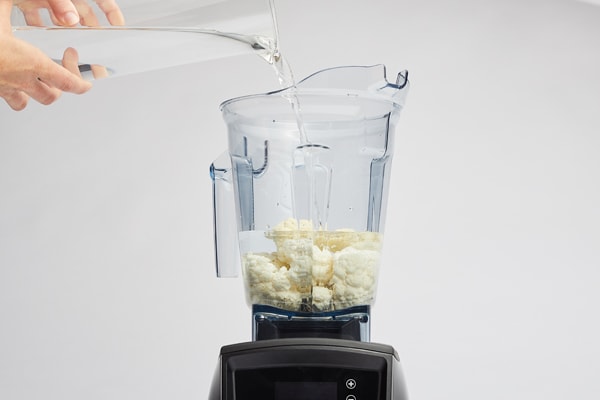
Advanced Blender Techniques
Interested in going beyond soups and smoothies? Here are more techniques high-performance blenders and accessories can perform.
Grinding
Grind and pulverize virtually any ingredient to create healthy, whole food dishes from scratch without added oil, sugar, or shelf stabilizers. Grind roasted nuts, freeze-dried berries, and coffee beans into a wide variety of textures that just aren’t possible with another appliance.
Add an advanced grinding function to your Vitamix blender with the Dry Grains Container.
Food Processing
Blenders can do almost everything a food processor can, but there are some tasks food processors do more efficiently and more precisely, like slice, shred, and chop.
The Vitamix Food Processor Attachment pairs with the motor base to perform all the precision slicing, chopping and processing of a premium, stand-alone food processor.
Chopping
With a few quick bursts of power, the pulse feature lets you rough chops ingredients without a knife.
Vitamix blenders have a lid plug opening for dropping ingredients through while the blades are moving. Try drop chopping garlic, carrots, peppers, onions, and more.
Making Dough
Some high-performance blenders can simulate the kneading process, so you can make everything from homemade pasta to sourdough bread with ease.
Vitamix blenders can grind whole-grain flour and knead dough.
Juicing
Blenders are great at extracting fresh juice and nutrients from fruits and vegetables. Simply blend fruit and vegetable ingredients with water to your desired consistency.
Unlike ordinary juicing machines that extract liquid but leave the nutrient- packed solids behind, a Vitamix blender is powerful enough to transform whole fruits and vegetables into pure, smooth juices.
Explore more advanced blending techniques here.
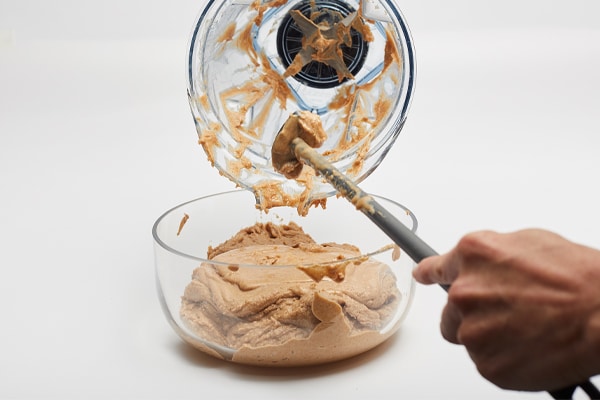
Blending Tips and Tricks for the Best Results
We’ve already discussed how loading your container and blending on high can help with better blends. Here are a few more:
Cover the Blades
Blenders need a minimum volume of ingredients in order to blend well. A good guide is to make sure you use enough ingredients to cover the blades while blending.
Master the Tamper
For thick, challenging blends, the Tamper can help get the mixture moving while breaking up air pockets that form around the blade. Simply rotate the tamper around the four corners of the container until a vortex begins to form and your blend is moving freely.
Every Last Bit
The Under Blade Scraper is specially designed to fit into every nook and cranny of your Vitamix container, so you get the most from each blend.
Blender Maintenance
The life of your blender depends on two things: how well it was made and how you use it. Inexpensive blenders simply aren’t designed to last a long time and there’s very little you can do to improve their longevity. Higher-end blenders are engineered for durability and, when used properly, they can last a lifetime.
Because high-performance blenders often feature complex technology and engineering, it’s best to follow the instructions in the owner’s manual. Tampering with your blender’s internal mechanisms could invalidate your warranty.
Vitamix blenders are covered by an industry-leading warranty and, since fewer than 2% of Vitamix products in the U.S. currently under warranty have been returned to us for service, it’s the best warranty you’ll probably never need.
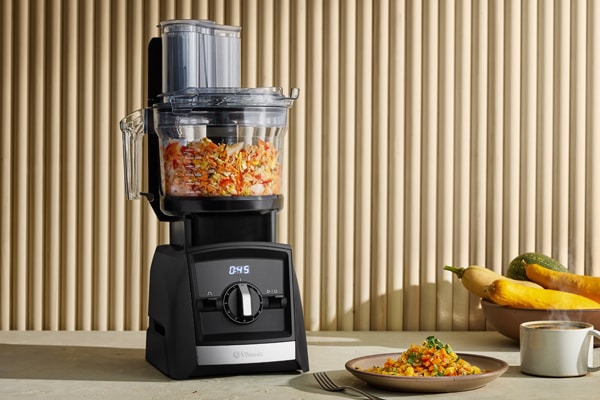
Blender Accessories and Add-Ons
Accessories can make your blender more versatile than ever. Vitamix blenders have the ability to perform the same tasks as 11 household kitchen tools. Check out these capability-expanding accessories and add-ons from Vitamix to see which one is right for you.
Kitchen Systems
Vitamix Smart Prep Kitchen System pairs a powerful motor with our versatile Food Processor Attachment giving you everything you need to make anything you want.
Accessories and Bundles
V1200 Super Pack
The Blending Cup & Bowl Starter Kit lets you personalize your Vitamix Ascent® Series blender. The 8-ounce Blending Bowl accommodates smaller servings of your favorite blends, while the 20 oz. Blending Cup lets you blend a single-serving smoothie and take it to go.
For more Vitamix accessories and add-ons visit Vitamix.com and discover a world of possibilities.
Frequently Asked Questions (FAQ)
What is the first thing you do when using a blender?
Read the Owner’s Manual. It’s designed to help you get the most out of your blender. If you misplace your Owner’s Manual, visit the manufacturer’s website. A digital version of most Vitamix manuals are available online.
How can I prevent my blender from overheating?
Check your blending speed and quantity, follow loading instructions, and use the tamper. These four guidelines should keep your motor functioning properly.
Can you use a blender without liquid?
Yes. Blenders are engineered to break down ingredients, even without liquid. The Vitamix Dry Grains Container’s specially designed blades can grind everything from whole grains to coffee beans.
My blender won’t start. What should I do?
There are many reasons for a blender to stall. Your owner’s manual is the best place to start troubleshooting.
Vitamix® motors are designed with Automatic Overload Protection to prevent them from overheating. If your Vitamix motor shuts off, follow these instructions:
Turn off the power switch for up to 45 minutes to reset. Reset time will be extended if high room temperatures exist. To reduce the reset time, unplug the machine, remove the container, and blow air into the center section of the bottom with a hair dryer on the cool setting.
If you are still unable to start your machine, please contact Customer Service.
How often should I replace the blender blades?
Generally speaking, high-quality blender blades can last for several years with regular use, while lower-quality blades may wear out sooner.
Vitamix blades are built to last and made to our exact specifications from hardened stainless steel. As we’ve said, Vitamix blade edges are blunt, not sharp – and that’s by design. Our blenders rely on the power of the motor and the speed of the blades to pulverize ingredients rather than slice them. Also, blunt blades are safer when scooping nut butter out of the container.
Whether you're a home chef, a health-conscious individual, or simply someone who appreciates the convenience of a well-equipped kitchen, we hope this guide helps you blend your way to smoother, healthier, whole-food creations.
